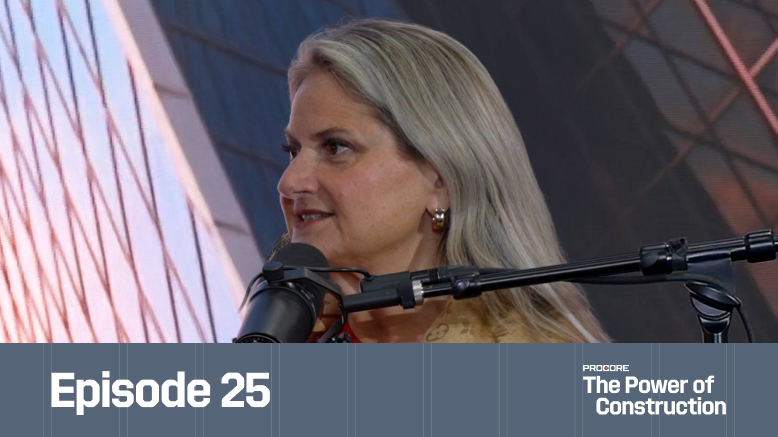— 6 min read
A Fine Line: Balancing Standardized Construction Processes With Specific Project Needs


Last Updated Oct 3, 2025

Lisa Leighton
Senior Director, Operational Excellence
As senior project controls manager, Leighton is responsible for discovering, developing and deploying best practices, as well as administering Ryan’s project management software and integrations between various tools, including financials. She draws knowledge and insight from 2 decades of construction experience, including work as a senior project coordinator and construction applications analyst. Leightonis detail-oriented and an experienced teacher, inspiring her teammates. She loves process improvement, training others, utilizing her project team experience and working with numbers. Lisa also enjoys the Ryan culture, people and variety of her work.

Kacie Goff
Contributing Writer
91 articles
Kacie Goff is a construction writer who grew up in a construction family — her dad owned a concrete company. Over the last decade, she’s blended that experience with her writing expertise to create content for the Construction Progress Coalition, Newsweek, CNET, and others. She founded and runs her own agency, Jot Content, from her home in Ventura, California.
Last Updated Oct 3, 2025

When it comes to the construction process, some general contractor (GC) firms formally adopt a mentality of continuous improvement. But even among those that don’t, construction teams know that getting better at how they do their work yields gains. More accurate estimating, planning and coordinating protect profit margins — and faster, smoother processes make for on-time project delivery.
For all of this, creating more, better processes seems like an obvious way to move the needle. The thinking goes that when teams can consistently replicate work, and identify and implement ways to refine that work, it gets easier to win on schedule, cost or both.
In some cases, that’s absolutely true. But a rush to implement new processes — particularly in tandem with the explosion of tech — has led to some frustration among GC teams.
One of the biggest issues that we're facing right now is that there are so many processes. It is a lot to keep in mind at the right time.

Lisa Leighton
Senior Director, Operational Excellence
Ryan Companies
Table of contents
The Challenge With Standardizing Processes in Construction
Companies in a broad range of industries benefit from standard operating procedures (SOPs). Whenever everyone follows the same steps to achieve an identified end goal, it creates consistency while smoothing bottlenecks. SOPs help to guide employees and build in quality control measures.
In construction, though, having an SOP for every task doesn’t always work. Challenges arise because every project is different. From varying geographies to unique owner requirements and expectations, any given project requires some level of agility and finesse.
We tell people you have to be operating as one [company]. It doesn't mean that every project has to utilize all of the same technologies and tools, though. Not every project uses drones, for example, because they’re not necessary on every project.
Lisa Leighton
Senior Director, Operational Excellence
Ryan Companies
At the very start of a project, owner preferences set it on a unique course. Some owners want to be involved every step of the way, while others only want to be notified of big changes and when project milestones are hit. GCs need their team to understand each owner, then pivot the project communication methods accordingly.
Then, on any project, those teams need to creatively problem-solve. Hard-and-fast SOPs could prevent an engineer from, say, exploring alternative materials that could best address the issue at hand. When process robs individuals of their ability to tap into their own expertise and ingenuity, it narrows the solutions they can offer. This can compromise project quality.
In short, construction projects require flexibility. Even if the process was developed to make life easier for the team, it adds a challenge if it’s overly rigid. An excess of processes — particularly ones with strict rules — can make people feel like their hands are tied, preventing them from doing their jobs well.
That’s not to say there’s no place for standardized processes at GCs, though.
How Process Can Benefit GCs
While every construction project comes with unique requirements and challenges, some project needs are universal (e.g., communication, safety). That means some areas benefit from standardization. When companies create processes that allow for flexibility, having standardized paths forward can help with the following issues.
Smoothing Bottlenecks
A set process becomes particularly valuable when it solves for a pain point the bulk of the team experiences. Take communication as an example. If some people email, some Slack, some call, some text, and some fax, communication gets dispersed.
People might be asking the same things over and over because the answer isn’t where they need it. Standardizing communication channels streamlines work for everyone. Inconsistent technology can similarly introduce bottlenecks — and having SOPs that identify which tools should be used when and how supports productivity.
Reducing Latency
As construction timelines tighten, every hour is important. Implementing processes to trigger next actions reduces latency and helps to maintain momentum so teams can move toward on-time delivery. Take pouring a concrete foundation as an example. If teams have a standard process to alert stakeholders when it’s time for next steps, lag between site prep, inspection/approval, the pour, and final inspection can all be shortened.
Supporting Safety
As a top priority for any GC, safety needs support. SOPs can help here. With checks, documentation, and procedures in place that teams can duplicate across projects, it gets easier to keep everyone safe.
Verification and Quality Control
Even though teams often need flexibility to manage the varied installation needs of each project, a standardized process to come in and verify completed work supports success.
Routinely confirming that things have been installed correctly supports quality control. Just as importantly, it minimizes rework. Consistent verification efforts mean that issues are caught early — when they’re easiest to correct.
Brand Consistency
A reliable experience helps build relationships with both owners and subcontractors. Say a GC firm works with the same owner on two projects, one in California and one in Florida. While those different locations probably mean very different teams working on each, the experience for the owner should be consistent. They shouldn’t have to wonder why one project’s change order looks different from another’s, for example.
Record-keeping & Audit Trails
When SOPs build in a step to log data, it helps teams track what’s been done. If they want to analyze historical data or pinpoint when something went wrong, that audit trail makes it possible. Technology can automate a lot of the record-keeping GCs need to resolve disputes and refine their processes.
Finding Balance on a Per-Project Basis
Since SOPs can be beneficial but every construction project requires flexibility, where does that leave GCs?
GCs' pain points are pinpricks of light to point them in the right direction. The challenges their team faces highlight precisely where SOPs might be most advantageous.
Zoom out to identify areas where projects commonly come up against issues. If something critical routinely gets missed or teams always experience the same kind of delay, that area is ripe for improvement. Implementing process there gives the GC a way to troubleshoot the recurring problem.
We have many Ryan standard processes and tools that have been implemented to provide the most efficient path forward for our teams. If a team wants to use another tool or complete a process differently, we first ask them: Why? Do they really need something else, or do they not fully understand the process or tool? If they ultimately do need something different, we work with the team to determine the best path forward.
Processes are established to help you and can be applied in most cases, but you need to be flexible and adjust to project requirements when appropriate.
Lisa Leighton
Senior Director, Operational Excellence
Ryan Companies
Within those standardized processes, room should always be left to keep teams agile and able to serve the project’s specific needs. Contract documents are a great example here: Having boilerplate language that covers the bases makes sense. But so does having an editable scope section, allowing the contract to speak to that project’s unique requirements.
In other words, standardized processes usually best serve the teams at GCs when they provide a template but leave room for teams to decide how to fill it in. It may even make sense to include options in the process so teams can choose what’s best for them on that particular project.
NOV 6, 2025 at 11:00 AM PST / 2:00 PM EST
Free Webinar: Prove your project management software is profitable
Join Procore and Dodge Data & Analytics for a 2025 Dodge ROI Report deep dive.

Was this article helpful?
Thank you for your submission.
0%
0%
You voted that this article was . Was this a mistake? If so, change your vote
Scroll less, learn more about construction.
Subscribe to The Blueprint, Procore’s construction newsletter, to get content from industry experts delivered straight to your inbox.
By clicking this button, you agree to our Privacy Notice and Terms of Service.
Thank you!
You’re signed up to receive The Blueprint newsletter from Procore. You can unsubscribe at any time.
Categories:
Written by

Lisa Leighton
Senior Director, Operational Excellence | Ryan Companies
As senior project controls manager, Leighton is responsible for discovering, developing and deploying best practices, as well as administering Ryan’s project management software and integrations between various tools, including financials. She draws knowledge and insight from 2 decades of construction experience, including work as a senior project coordinator and construction applications analyst. Leightonis detail-oriented and an experienced teacher, inspiring her teammates. She loves process improvement, training others, utilizing her project team experience and working with numbers. Lisa also enjoys the Ryan culture, people and variety of her work.
View profile
Kacie Goff
Contributing Writer | Procore Technologies
91 articles
Kacie Goff is a construction writer who grew up in a construction family — her dad owned a concrete company. Over the last decade, she’s blended that experience with her writing expertise to create content for the Construction Progress Coalition, Newsweek, CNET, and others. She founded and runs her own agency, Jot Content, from her home in Ventura, California.
View profileExplore more helpful resources

Profit from Predictability: Construction Software as a Business Strategy
For general contractors, managing complex, multi-million-dollar projects, every project phase — from planning and budgeting to on-site execution — is an opportunity to lose time and money. Construction software is...

Defending Against Financial & Legal Risks on Megaprojects
The construction industry has seen marked growth in megaprojects. Some experts classify any project over $500 million as a megaproject, while others argue that the build needs to be $1...

Unlocking Project Intelligence: Moving from Raw Data to Actionable Insights
The construction industry faces a wide range of challenges, from ongoing labor shortages to frequent cost overruns. But some the biggest hurdles all stem from unpredictability. The general contractors (GCs)...

Who is accountable for innovation in construction?
Everyone says construction needs to innovate—but no one agrees on who’s actually responsible for making it happen. Is it the owner? The builders? The tech vendor? Or is innovation everyone’s...
Free Tools
Calculators
Use our calculators to estimate the cost of construction materials for your next project.
Templates
Find a template to help you with your construction project tasks.
Material Price Tracker
Get the latest U.S. retail prices and view historical trends for common building materials.
Glossary
Explore key terms and phrases used in the industry.
